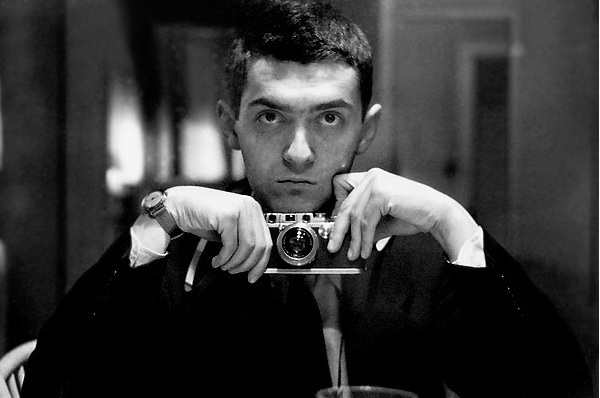
Self-portrait of Stanley Kubrick with a Leica III camera
Source: LOOK Magazine Collection, Library of Congress
On April 2, 1968, Stanley Kubrick’s seminal film “2001: A Space Odyssey” premiered at the Uptown Theater in Washington, D.C. Thematically, the film deals with elements of human evolution, technology, artificial intelligence, and extraterrestrial life. It is notable for its scientific accuracy, pioneering special effects, ambiguous imagery, sound in place of traditional narrative techniques, and minimal use of dialogue. Despite initially receiving mixed reactions from critics and audiences alike, today 2001: A Space Odyssey is nearly universally recognized by critics, film-makers, and audiences as one of the greatest and most influential films ever made. It was described as ‘culturally, historically, or aesthetically significant’ by the United States Library of Congress and selected for preservation in the National Film Registry in 1991.
“I tried to create a visual experience, one that bypasses verbalized pigeonholing and directly penetrates the subconscious with an emotional and philosophic content. I intended the film to be an intensely subjective experience that reaches the viewer at an inner level of consciousness, just as music does; to ‘explain’ a Beethoven symphony would be to emasculate it by erecting an artificial barrier between conception and appreciation. You’re free to speculate as you wish about the philosophical and allegorical meaning of the film – and such speculation is one indication that it has succeeded in gripping the audience at a deep level – but I don’t want to spell out a verbal road map for 2001 that every viewer will feel obligated to pursue or else fear he’s missed the point.”
– Stanley Kubrick, Interview in Playboy Magazine (1968)
A Journey Beyond the Stars
In order to create a science fiction movie about extraterrestrial life and about mankind’s relation to the universe, Stanley Kubrick searched for a collaborator after Dr. Strangelove [4] had been completed, and found the science fiction writer, science writer, inventor, and explorer Arthur Clarke. On February 23, 1965 their project was announced in a press release as ‘Journey Beyond The Stars’. ‘2001: A Space Odyssey‘ was selected in April of the same year. Apparently, Kubrick intentionally used Homer’s The Odyssey as an inspiration as he said “that for the Greeks the vast stretches of the sea must have had the same sort of mystery and remoteness that space has for our generation“.
How to depict a Extraterrestrial Intelligence
In his book The Cosmic Connection, famous astronomer Carl Sagan wrote that both Clarke and Kubrick asked his opinion on how to best depict extraterrestrial intelligence in their film.[6] It is believed that Sagan argued that alien life forms were unlikely to bear any resemblance to terrestrial life. Further Carl Sagan is said to have proposed that the film suggests, rather than depict, extraterrestrial superintelligence. In 1972, excerpts from Arthur Clarke’s diary were published in which he described his involvement with the film. Apparently, many changes were made during production for logistic reasons. For example the team responsible for the special effects was unable to develop a convincing rendition of Saturn’s rings. Therefore, they switched to Jupiter. The filming of all actors was completed in fall 1967 and the next months were used by Kubrick and his team to work on the notable special effects. The color processing and 35 mm release prints were done using Technicolor’s dye transfer process. The production was $4.5 million over the initial $6.0 million budget, and sixteen months behind schedule.
A Spacemark in the Art of Film
In March 1968, Kubrick finished the ‘pre-premiere’ editing of the film, making his final cuts just days before the film’s general release. The film premiered on April 2, 1968 and cost more than $10 million. Although the first reviews upon release were quite mixed, it was declared as one of the most important films later on. After its release, Charles Champlin of the Los Angeles Times opined that it was “the picture that science fiction fans of every age and in every corner of the world have prayed (sometimes forlornly) that the industry might some day give them. It is an ultimate statement of the science fiction film, an awesome realization of the spatial future … it is a milestone, a landmark for a spacemark, in the art of film.” [8]
Special FX
The film paved the way for the front projection used in the African scenes. This involved projecting slides of an African landscape via a semi-transparent mirror onto a highly reflective screen, in front of which the actors of the ape-men then acted. This technique produced far more realistic images than other methods available at the time, but has since been generally supplanted by more flexible, computer-based bluescreen techniques. For the first time, very large and extremely detailed models were built to show the space sequences, with the outer skin covered with details from plastic model kits. The space station measured more than 2 meters in diameter, and Discovery was nearly 20 meters long. These models were filmed using a precursor system of motion control technology. Everything ran on rails and was movable by motors to allow the camera to move extremely slowly and heavily dimmed along the models. The dimming avoided depth blurs that would have immediately exposed the models as such.
The impeller, in which the astronauts complete their fitness program, cost $750,000 (out of a total budget of $10.5 million). The centrifuge, which weighed 30 tons and was three meters wide and nine meters in diameter, was manufactured by the British company Vickers Engineering and made it possible to position the cameras on rails. The outer walls were rotatable, giving the impression that astronauts could jog upside down or climb out of a shaft.
A Generation’s Big Bang
Indeed, the influence of the film was enormous. Steven Spielberg described 2001: A Space Odyssey as the (film) generation’s big bang, and George Lucas once even noted:
“Stanley Kubrick made the ultimate science fiction movie, and it is going to be very hard for someone to come along and make a better movie, as far as I’m concerned. On a technical level, it can be compared, but personally I think that ‘2001’ is far superior.”[9]
Next to its influences in the media, 2001: A Space Odyssey is also said to have inspired technology and the field of law. In 2011, Apple Inc. and Samsung fought in a lawsuit over the patents of the tablet and latter is supposed to have explained that ‘Apple’s iPad was effectively modeled on the visual tablets that appear aboard spaceship Discovery in the Space Odyssey film, which legally constitute prior art. Legally, prior art is information that has been disclosed to the public in any form about an invention before a given date that might be relevant to the patent’s claim of originality.
Moreover, the film was the most financially successful of the 1968 film year, grossing over $190 million in theaters worldwide. The film won the Hugo Award for best dramatic presentation, as voted by science fiction fans and published science-fiction writers. It was nominated for four Academy Awards and won the Oscar for Best Special Visual Effects.
Stanley Kubrick’s 2001: A Space Odyssey – In Discussion (2014 BBC), [10]
References and Further Reading:
- [1] Behind the camera of 2001: A Space Odyssey
- [2] Sir Arthur C. Clarke: Odyssey of a Visionary: A Biography
- [3] 25 Things You Didn’t Know About ‘2001: A Space Odyssey’
- [4] Edward Teller and Stanley Kubrick’s Dr. Strangelove, SciHi Blog
- [5] Breaking New Grounds in Cinematography – Stanley Kubrick, SciHi Blog
- [6] Carl Sagan’s Cosmos, SciHi Blog
- [7] 2001: A Space Odyssey at Wikidata – BTW, I just realized that Kubrick’s Wikidata ID is Q2001 😉
- [8] Champlin, Charles (5 April 1968). Review of 2001 reprinted from Los Angeles Times in Agel 1970, pp. 213–215.
- [9] Coate, Michael. “1968: A Roadshow Odyssey- The Original Reserved Seat Engagements Of ‘2001: A Space Odyssey’“. in70mm.com.
- [10] Stanley Kubrick’s 2001: A Space Odyssey – In Discussion (2014 BBC), A panel discussion on the history of Stanley Kubrick’s film, 2001 A Space Odyssey. Featuring Dr. Brian Cox, with actors Keir Dullea and Gary Lockwood., ados4k @ youtube
- [11] Roger Ebert’s Essay on 2001
- [12] Timeline for Stanley Kubrick, via Wikidata





